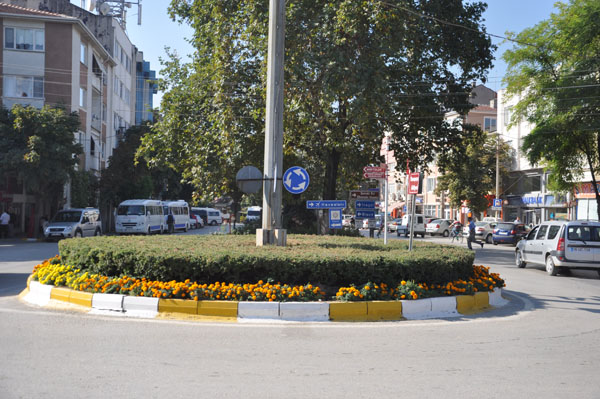
Yenişehir is a district of Bursa Province, located 61 km east of the city center. It hosts the first airport of Bursa. The district’s economy is based on agriculture and livestock, with a particular emphasis on agricultural exports, especially tomatoes and peppers, which are world-renowned. The region experiences a mild Marmara climate.
History
Founded by the Byzantines, Yenişehir became a base for the Byzantine army during their campaigns in Anatolia due to its proximity to İznik and its fertile land. Osman Gazi captured the city following the Battle of Koyunhisar and briefly made it the capital. After Bursa was conquered, the capital function was transferred to the main city. Yenişehir is among the developing districts of Bursa.
The First Capital of the Ottoman Empire
The known history of Yenişehir dates back to the early 14th century. While there are mentions of a Byzantine city called "NEOPOLIS" in earlier centuries, no significant evidence has been found. After Osman Bey’s conquests of Köprühisar and Yarhisar, he added the Yenişehir plain to his territory and allocated the area to his warriors as land for settlement, marking the first time it was opened for settlement. Yenişehir is named as such because it was opened for settlement at that time. The historian İsmail Hakkı Uzunçarşılı mentions in his book Osmanlı Tarihi that "a Turkish city was established in the plain, and due to its proximity to the battlefield, it became a headquarters."
These facts indicate that Yenişehir was established as a Turkish city and opened for settlement. Yenişehir, a Turkish city with a history spanning 680 years, was occupied by Greek forces between October 27, 1920, and September 6, 1921, and was liberated on September 6, 1921. The establishment of villages dates back further, such as Yarhisar, which served as the Tekfur Barracks during the Byzantine era. Additionally, historical remnants from the Byzantine period, such as castles, have been found in the villages of Akbıyık and Süleymaniye. The Ottomans built many historical structures in the city, and out of the 17 mosques in the town center, 10 are from the Ottoman era. Other historical structures in the district include the Babasultan Zaviyesi, Sinanpaşa Mosque and Caravanserai, Çiftehamamlar, Süleymanpaşa Mosque and Tomb, Saray Hammam, and Şemaki House.
When discussing the history of Yenişehir, it is noted that Osman Bey, the founder of the Ottoman Empire, spent his childhood in Yarhisar and achieved great victories against the Byzantines in the Koyunhisar plain, which facilitated the westward expansion of the Ottomans. During these battles, Osman Bey’s brother Aydoğdu Bey was martyred, and his grave is still located in Koyunhisar village. During the War of Independence, the district also witnessed guerilla warfare, with Greek and Armenian forces in the villages of Marmaracık and Derbent causing significant harm to the local population. Müstecip Onbaşı, who is said to have placed the artillery shell that sank the British destroyer in the Gallipoli campaign, hails from the Orhaniye village of Yenişehir, and his grave is located in the same village.
Culture and Tourism
Yenişehir, located 45 km east of Bursa, was known as Neopolis in ancient times. The district, incorporated into the Ottoman lands during the reign of Osman Gazi, was granted to his warriors as land under the name of "kılıç hakkı." The city established here was named Yenişehir.
Yenişehir, rich in historical Ottoman architecture, is home to several significant historical buildings, including the Saray Hammam (from Osman Gazi’s time), the Postinpuş Baba Zaviyesi from the reign of Murad I, Voyvoda Mosque (Çınarlı Mosque) built in the 14th century, Koca Sinan Paşa Complex from the 16th century, Bali Bey Mosque, the Ulu Mosque built by Orhan Bey, Süleyman Paşa Complex, Çifte Hamam built by Deli Hüseyin Pasha in 1645, Yarhisar Village's Orhan Mosque, and the Clock Tower.
Yenişehir Şemaki House Museum
Located in the center of Yenişehir, 55 km from Bursa, the house was built by the Şemaki family, who moved from Şemah, Iran, to Yenişehir in the 18th century. The two-story house has a stone floor on the ground level, with a kitchen and pantry on the right, and two winter rooms on the left. The wooden stairs lead to the upper floor, and the front facade, overlooking the garden, opens with arched sections. The house is decorated with botanical motifs and landscape murals from the 19th century. The bath section, mentioned to be in the garden, no longer exists. The museum is open for visits during working hours, except on Mondays.
Population
The population living in the villages is 52.4% of the population in the city center. According to the 2000 census, the population of the district is 54,835, with 26,068 residing in the town center and 28,767 in the towns and villages. The district is composed of 61 villages and 10 neighborhoods, excluding the town center. The main source of income in the district is agriculture, with 78.7% of the population engaged in agricultural work. All the villages depend on agricultural production for their livelihood, and additionally, 14,380 people in the town center also rely on agriculture.
Population Density: 71/km²
Population Growth Rate: 3.45%
Newşehir's Population as a Proportion of Bursa's Population: 2.6%
The proportion of Village Population to Yenişehir's Population: 52.4%
Road Transport
Yenişehir is located 25 km from the north (Iznik district), 27 km from the south (İnegöl district), 40 km from the west (Bilecik province), and 55 km from the east (Bursa province). Scheduled bus services operate to Yenişehir from all four cities.
Air Transport
Yenişehir International Airport provides civil aviation and cargo transportation to destinations around the world. There are also scheduled flights to Ankara, Istanbul, Izmir, and Trabzon.